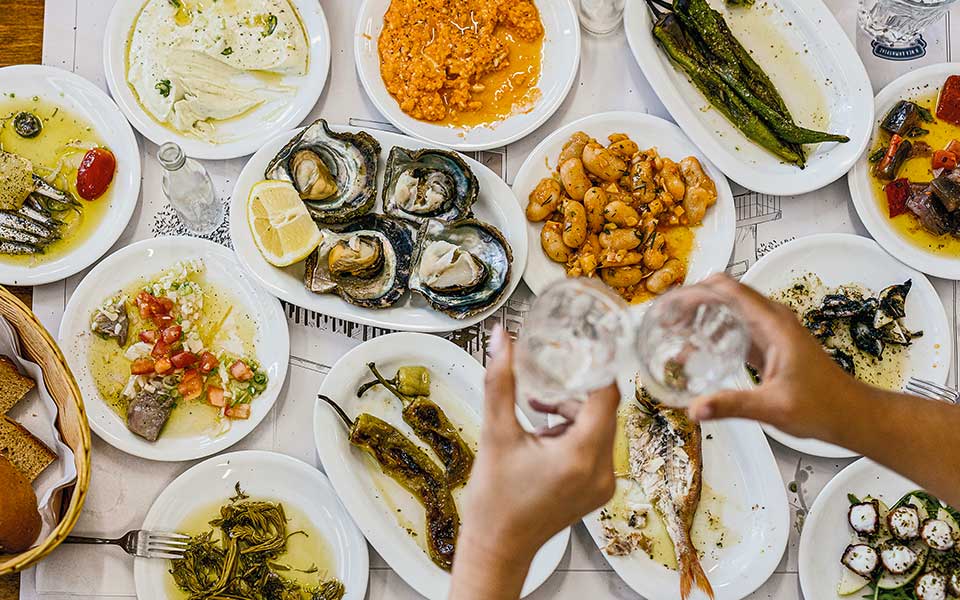In Volos, tsipouro shops are more than just places to get a drink; they’re a microcosm of the neighborhood and an integral element of the city’s culture. Everybody has a treasured memory. Older generations remember the smell of sawdust used by store owners to clean their spaces so that patrons wouldn’t slip or how they had to learn to drink tsipouro with anise because tsipouro without anise was for the uninitiated.
Others recall great loves born in these shops or fleeting passionate flirtations. Many women recall first visiting tsipouro shops after the 1970s, because they were considered taboo for women before then. The younger generation recalls eating grilled octopus and drinking orange juice with their parents at a tsipouro shop. Others recall business meetings, marriage proposals, farewells, celebrations, graduations, or their military service.
A person’s entire life is linked to the tsipouro shops. It’s as if these shops serve as an outlet for the people of Volos to unwind and socialize. In the afternoons, the locals are always there – a habit that Volos residents do not easily abandon. They’ll even introduce visitors to their custom in their own unique way. They order tsipouro with or without anise – each round is accompanied by delicious mezes that have been selected by the shop – and surrender themselves to the ritual, a unique local experience steeped in history.
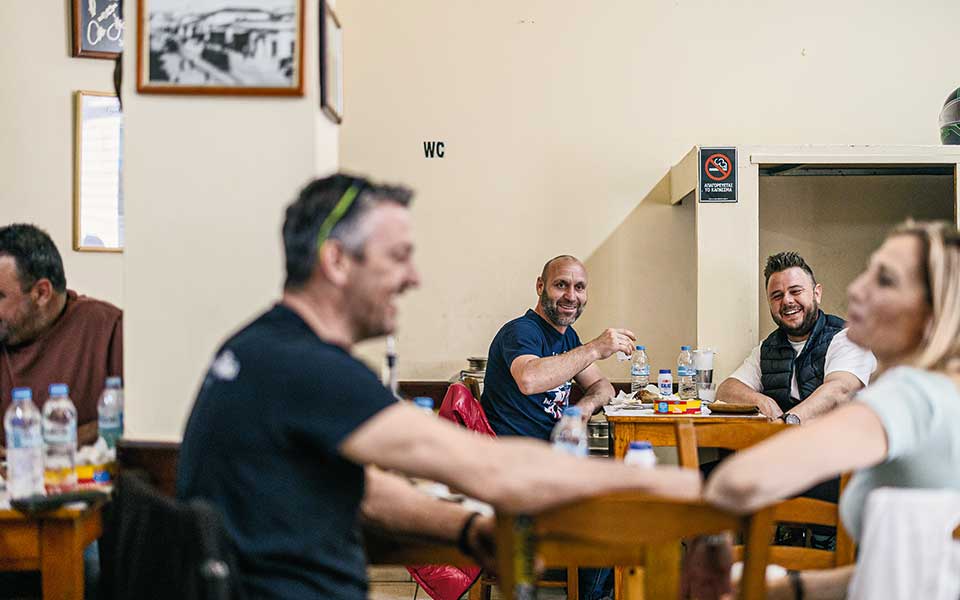
© Angelos Giotopoulos
The beginning
Until the early 20th century, tsipouro arrived in Volos primarily from the nearby town of Tyrnavos and the villages around Mount Pilio. Initially, tsipouro was served without mezes to whet the appetite before lunch. These were first introduced by longshoremen and fishermen who drank tsipouro in the afternoon after work and grilled fish or octopus as a snack. The person who brought the mezes also had the only knife in order to divide the mezes equally. This tradition continues to this day; in Volos’ tsipouro shops, it’s common to see just one knife on the table.
Fotis Papadis opened his shop in 1954. The counter would already be full when the shop started serving at 10 a.m. “At first, we worked all day, spending long hours on our feet, until the doctor advised me to work less. I took his advice and started closing in the afternoon,” recalls Fotis. “Even though it was hard work, I enjoyed it. The shop had a family atmosphere; relationships were almost fraternal among the customers; they had to drink their tsipouro at the counter because we didn’t have any tables.” Shop owners would even spy on their competition, asking their waiters to check why other shops are busier.
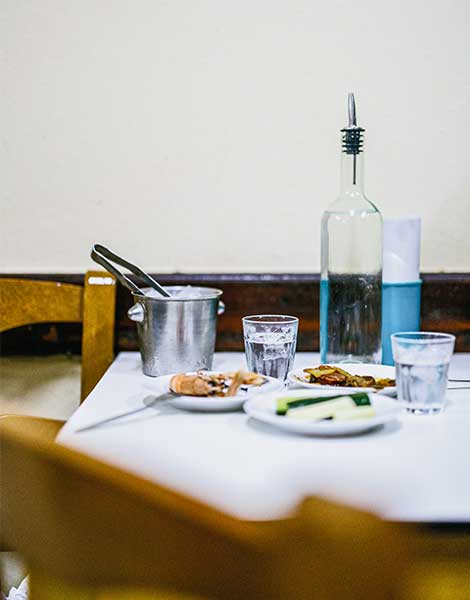
© Angelos Giotopoulos
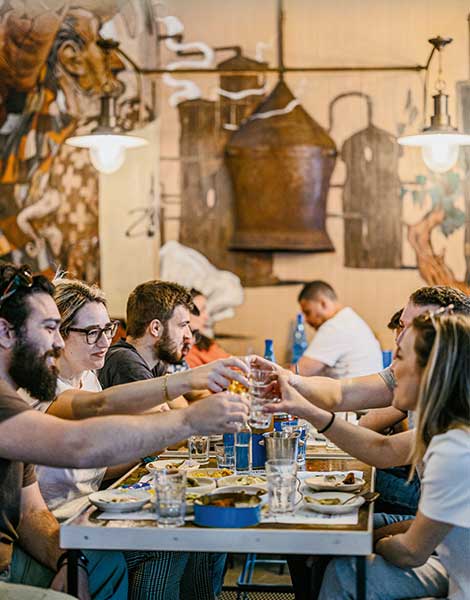
© Angelos Giotopoulos
This is how mezes gradually evolved and became a staple. In the beginning, tsipouro shops would serve cured meats, sardines, and mackerel, as well as pickled peppers. Then came octopus, French fries, and cheeses (primarily manouri cheese), while some shops also served meatballs. Everything was prepared on the grill, but fried mezes, such as shrimp and small fish, were added later. All the other mezes, such as crayfish, lobster, and shellfish, were introduced by Greek refugees from Asia Minor. The locals didn’t serve them because they didn’t know how to prepare them. When fishermen caught them, they would toss them back into the water.
Many Greek refugees from Asia Minor, who had fled to Volos after the 1922 Asia Minor Catastrophe, working as fishermen or longshoremen, opened tsipouro shops in the refugee district of Nea Ionia. They used to drink tsipouro after work in the coffee shops near the port and later in the backstreets of Nea Ionia.
There is no definitive answer as to who was the first to open a tsipouro shop in the form that they are now found in Volos. They arose because of the need for survival, cultural exchange, and interaction between the locals and the refugees from Asia Minor. Since the 1970s, the city has been associated with tsipouro shops. They became such a popular and established feature of Volos that people would say, “Let’s go to Mandra for meat, Larisa for music, and Volos for tsipouro.”
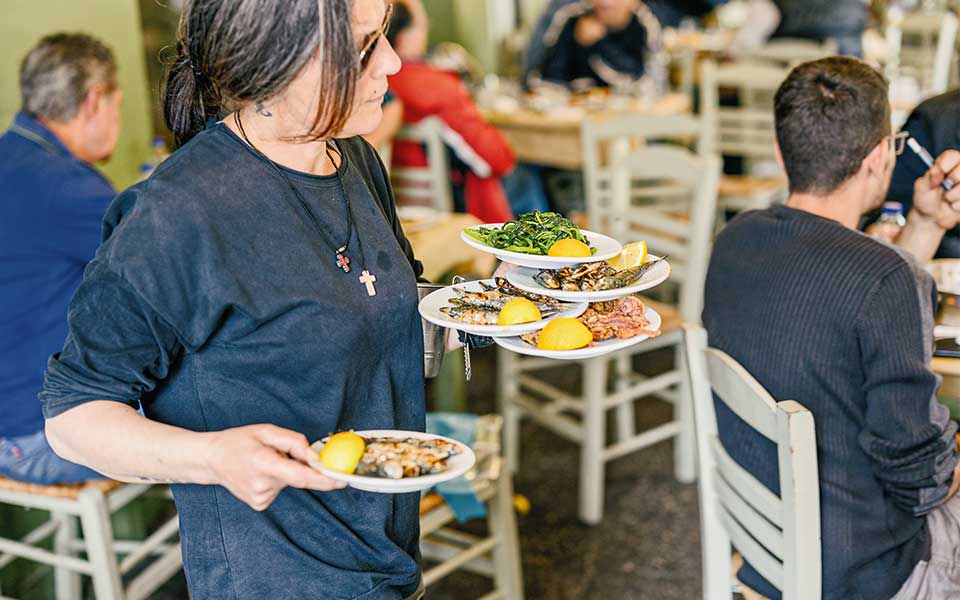
© Angelos Giotopoulos
Tsipouro shops are still evolving today. Everyone has a favorite spot, but it’s difficult to know which ones are authentic if you’re unfamiliar with the culture. With time, tsipouro shops changed, with many new shops sacrificing quality for profit. This is all too familiar to Alexandros Psychoulis, an artist and professor at the University of Thessaly and author of the book “Tsipouro in Volos,” whom I met at the tsipouro shop “Nikos and Gianna” in the Palaia district.
The chairs are turned sideways here, indicating that the customer is not here to eat, but to enjoy a glass of tsipouro. Since you come here to chat with your friends, there is no music, and since the tsipouro serves as entertainment, there is no television. Naturally, as in the past, the store is only open in the afternoons. Tucked away in a small alley, “Nikos and Gianna” is not very big and doesn’t have a sea view. The tables are set with paper tablecloth and a small metallic cup containing wax paper that can be used as a disposable plate or to wipe your hands. Small plates, small forks, small glasses, one knife as a tribute to the first tsipouro drinkers, a breadbasket, and a bottle of water – a must since the purpose of tsipouro is to unwind and escape from everyday life rather than get wasted.
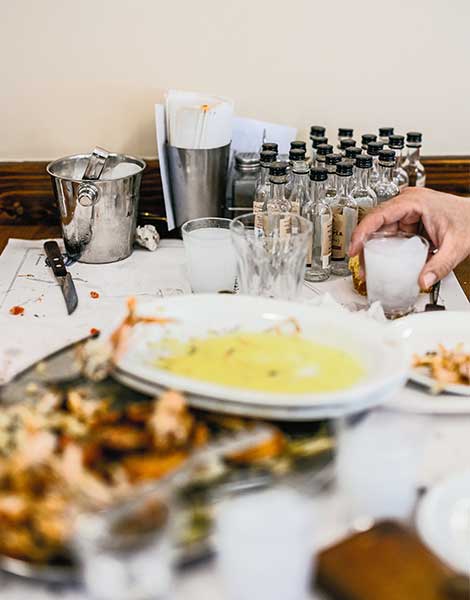
© Angelos Giotopoulos
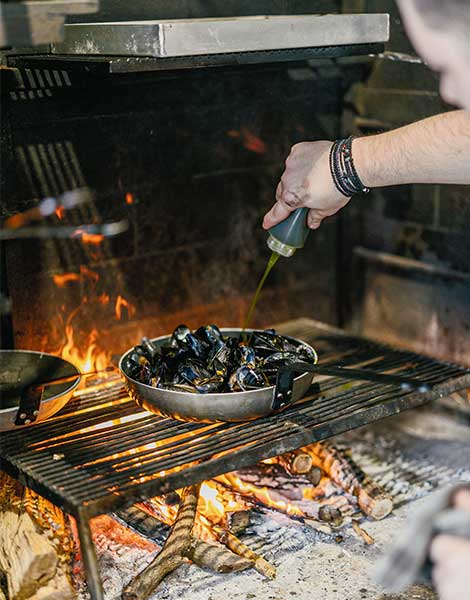
© Angelos Giotopoulos
The ritual
A round of tsipouro is served as soon as we take our seats. The first clink of our glasses signals the start of a communal gastronomic gathering. “Tsipouro is traditionally drunk in the afternoon. Whiskey is typically drunk at night, when things get serious,” Alexandros explains. “I recall my grandfather coming home from work in the afternoon smelling of tsipouro. He would always stop at a tsipouro shop for a drink and a bite to whet his appetite for lunch. Today, tsipouro shops have become destinations in their own right, where people go to take a break from work in the afternoon. Many return to work, but not if they have drunk too much. Four rounds are enough. In fact, tsipouro helps if your work requires you to interact with others,” he adds.
When the mezes arrive, Alexandros divides them evenly. “Trying to figure out who was the first to open a tsipouro shop is like trying to figure out who came up with a particular joke. It was a collaborative process,” he explains. “Gianna,” he calls out, alerting the owner that we require more tsipouro. The waiter brings us another round along with more mezes. “It’s important to have a good relationship with your waiter if you want to have good service,” he says. “The waiter does more than just serve you; he looks after you. So, it’s good to know his name. You can discreetly explain to him that you don’t like shellfish and prefer cured meats instead; as a rule, your wishes will be respected. His goal is to ensure that you have a good time and leave satisfied. He always knows which round you’re on and what mezes need to be served with the next one, even when the shop is busy.”
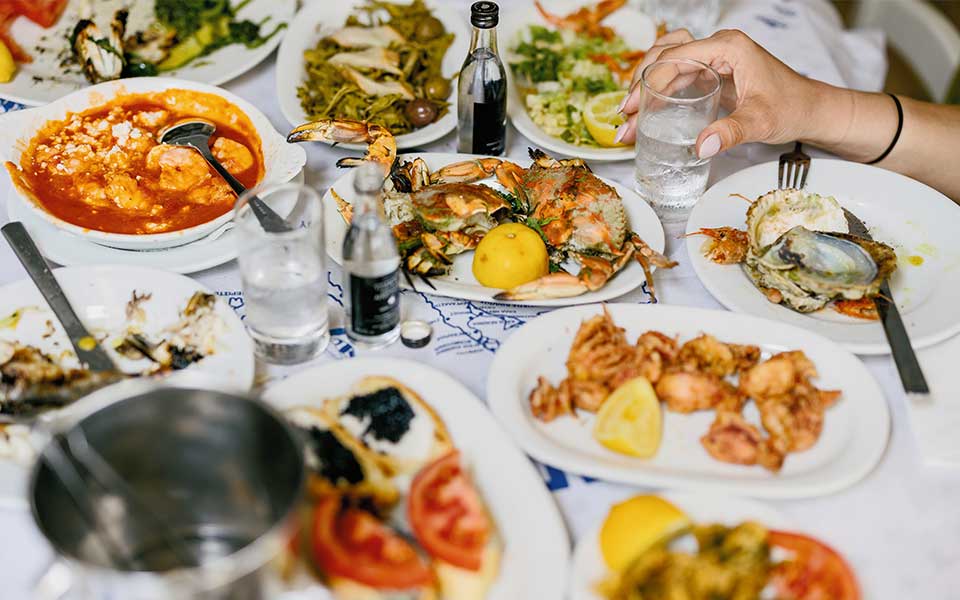
© Angelos Giotopoulos
“It’s liberating not having to think about what to order. Every tsipouro shop has its own identity based on the mezes it serves. It’s a matter of preference whether one shop makes fried dishes, another specializes in traditional Greek dishes, or has an experienced griller. For me, grilled crayfish with coarse sea salt or fried red mullet are perfect mezes. I prefer the simple things.”
Plates begin to pile up on our table as time passes. The waiter will never remove plates that still have even a few morsels on them; these last pieces are always the best. “When you’re in love, the best place to go is a tsipouro shop. Tsipouro and flirting go well together. That’s where I met the love of my life, although there is tsipouro-love too, which fades away when the effects of alcohol wear off,” he says with a laugh. Street musicians playing the clarinet and the toubeleki entertain the customers. When they are done playing, they discreetly pass by each table, asking for money – a common sight. “Drinking, having a few mezes, talking, and having a good time – this is what tsipouro is all about. If you stick to the ritual, you won’t wake up with a hangover,” Alexandros adds.

© Angelos Giotopoulos
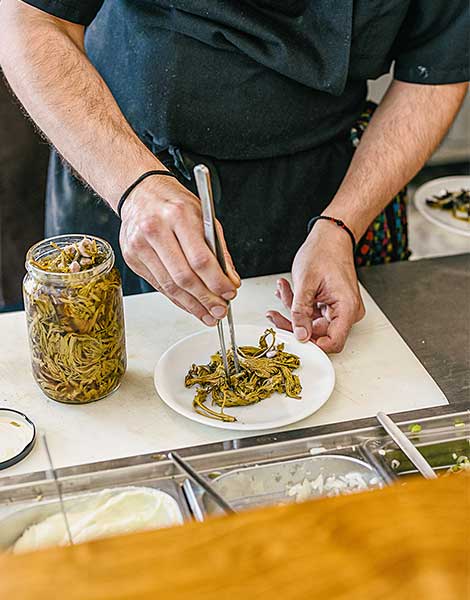
© Angelos Giotopoulos
The mezes
A tsipouro shop’s menu is always a source of heated and informed debate. The purpose of the mezes is to accompany your tsipouro rather than to fill you up. There are far too many of them, and because they are served without having to be ordered, they’re regarded as an offering, a gift from the shop to the customer, a social exchange. There are raw smooth clams, terebinth shoots, wild fern shoots, and crithmums that are served plain or with salted fish; fried or grilled angler tails, octopus, potatoes, and mackerel, herring, or sardines that are often accompanied by chopped pickled vegetables or cabbage; fried calamari, taramosalata (salted roe spread), red mullets, and rays.
Shellfish is also very popular; in addition to the traditional mussels and smooth clams, you will also find scallops, rock shells, ark clams, and sea figs. Shops will also serve specialty items to connoisseurs, such as angler liver, crayfish, or seafood pasta. Some of the more uncommon mezes include sea urchins, Patellidae, and bottarga from Messolongi, while fresh anthotyro cheese with a spoonful of tomato paste on the side, tirokafteri, and kopanisti (cheese pastes) are more traditional. Many tsipouro shops close with eggs and pastirma.

© Angelos Giotopoulos
The next generation
When a tsipouro shop is passed down to the next generation, there is always the worry that it will not be as good as it once was, and locals always viewed new tsipouro shops with skepticism. That was until “Mezen” opened its doors and won over the city with its high-quality gourmet mezes and more than 35 types of bottled tsipouro. Local Volos chef and 2018 Masterchef winner Timoleon Diamantis took over the historic “Ouzeri Karakatsanis” when it closed in 2021. Since it first opened in 1969, it had been one of the city’s most well-known tsipouro shops, famous for its angler fish and crayfish. Timoleon had been a customer since he was a teenager, and he and his childhood friend Aggelos Argiris decided to carry on the tradition. Timoleon prepares traditional and more uncommon mezes on an open charcoal or wood fire, as well as in a wood stove oven.
Sakis Papoulias, from Zagora, recently took over the legendary tsipouro shop “Kavouras,” where had been a regular customer since the age of 15. “Mr. Alokos came to me and said, ‘I want you to take over the shop because I’m retiring.’ I told him that I didn’t have the money, but he said we were going to figure something out. Zisis, the shop’s head waiter, continues to work alongside him, and customers have welcomed the new owner with open arms. Today, the shop is busier than ever. They only use fresh and seasonal ingredients, and the shop’s legendary baked potato, which is prepared in a makeshift oven at 6 a.m., the same way it used to be made in 1956, is still on the menu.

